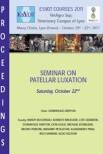OBJECTIVES:
To assess whether the bisection of the fabellae by their respective femoral cortices is a useful criterion for assessing positioning of craniocaudal pelvic limb radiographs, and whether this is consistent in limbs affected or unaffected by medial patella luxation.
METHODS:
Computed tomography multi-planar reconstructions were used to determine the relative positions of the fabellae with respect to the femoral cortices.
RESULTS:
Only 36% of fabellae overall were bisected by the femoral cortex. There was no significant difference between limbs affected or unaffected by medial patella luxation.
CLINICAL SIGNIFICANCE:
The accurate measurement of femoral varus angle is important in pre-surgical planning of distal femoral ostectomy. Radiography is normally used to obtain the femoral varus angle, and femoral rotational malpositioning will induce errors in the femoral varus angle measured. Bisection of the fabellae by the femoral cortices is commonly cited as a criterion by which to assess whether a radiographic projection is truly craniocaudal, yet this study has shown this not to be valid.









